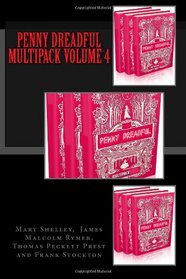Search -
Penny Dreadful Multipack Volume 4
Penny Dreadful Multipack Volume 4
Author:
Get ready for the new Showtime horror series ?Penny Dreadful? coming this May with Volume 4 of the Penny Dreadful Multipacks! Included in this bundle: ?Frankenstein? (1818 Version) by Mary Shelley; ?The String of Pearls? (Sweeney Todd) by James Malcolm Rymer and ?The Lady or the Tiger? by Frank Stockton. Plus, original essay 'What is a P... more »
Author:
Get ready for the new Showtime horror series ?Penny Dreadful? coming this May with Volume 4 of the Penny Dreadful Multipacks! Included in this bundle: ?Frankenstein? (1818 Version) by Mary Shelley; ?The String of Pearls? (Sweeney Todd) by James Malcolm Rymer and ?The Lady or the Tiger? by Frank Stockton. Plus, original essay 'What is a P... more »
ISBN-13: 9781499518047
ISBN-10: 1499518048
Publication Date: 5/10/2014
Pages: 438
Rating: ?
ISBN-10: 1499518048
Publication Date: 5/10/2014
Pages: 438
Rating: ?
0 stars, based on 0 rating
Publisher: CreateSpace Independent Publishing Platform
Book Type: Paperback
Members Wishing: 1
Reviews: Amazon | Write a Review
Book Type: Paperback
Members Wishing: 1
Reviews: Amazon | Write a Review
Genres:
- Literature & Fiction >> Short Stories & Anthologies >> Anthologies
- Literature & Fiction >> Anthologies & Literary Collections >> General




